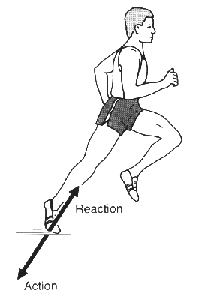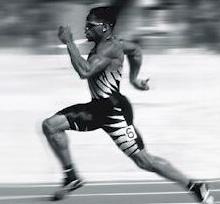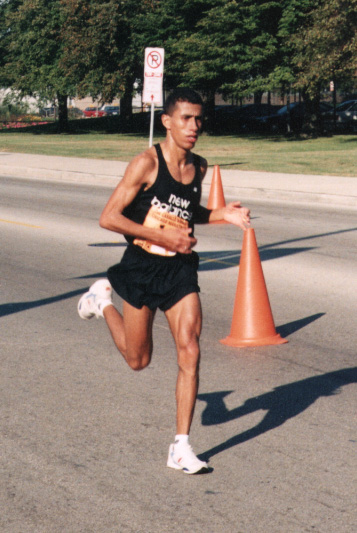
Forces and Efficiency
Jesse Owens(left): 4 Gold medals 1936 Olympics
(Click on Jesse to read Article)
 |
Picture courtesy of http://www2.iaaf.org/TheSport/sport/100/Expert.html
Forces
Newton's Third Law(Above): For every action there is a reaction equal in amount but opposite in direction. With every foot-strike, the surface pushes back with a force equal to the impact force, driving the runner upward and forward in a direction opposite to that of impact.
Leg/Foot Forces: When the foot strikes the ground, the legs swing downwards and backwards because from a subjective point of view it seems to the sprinter that the ground is coming towards him. As the next foot strike occurs, the foot will be moving backward with a velocity equal to but in the opposite direction of the body. The supporting phase where the foot is on the ground is only 0.08 s to 0.09 s long. Forces of up to 3.5 times the body weight in vertical direction and a single body weight in horizontal direction are acting during the supporting phase. For this reason strength is important for obtaining high velocity running speeds.
Upper Body: Stronger legs must also have a correspondingly strong upper body because (according to biomechanical laws) the swinging arms must produce equal opposite forces to those of the legs. This explains the generally very strong appearance of sprinters. Compare the pictures of the sprinter and long distance runner below.
Ato Boldon of Trinidad: 100/200 meter runner |
Khalid Khannouchi(USA): Marathon World
Record Holder |
 |
 |
| Picture courtesy of http://www.nd.edu/~jvanders/trackpics/trackpic.html | Picture courtesy of http://www.uwec.edu/Academic/Curric/hartnesg/hartnett/CHIMAR/18MI.htm |
Efficiency
Energy cost: Efficient runners are refined to ensure that movements occur in proper direction, with optimum quickness to minimize the loss of kinetic energy. This can be seen with the flexion and extension of the lower limbs, and how these movements work with the rotation, abduction, adduction of the hips and spine. All these movements about various planes must be complementary. (Cavanagh & Kram, 1990).
Stride frequency: This is the turn over rate of the runner's legs. An efficient stride is performed without exerting unnecessary energy. Shortening the length of the legs, by bringing the foot up to the buttocks before extending, allows a runner to perform a stride with the least energy.
Stride length: This is the measurement between successive foot-strikes. With proper stretching, this can be performed with minimal energy, or most efficiently.Why Stretch? This ensures that the most important muscles for movement are used effectively. This includes the coordination of agonists, antagonist, and synergist. This will result in minimum energy used to initiate the movement, and minimal opposing resistance.
Did you know? Stride Length or Stride Frequency:
When a runner increases his or her velocity, their stride length increases but their stride frequency actually remains constant. A short person has a smaller period than a taller person, and so naturally the short person will have a higher stride frequency. But a tall person will have a larger natural stride length.
Increasing speed:
For both runners, the key to increasing your speed is to increase not stride frequency, but stride length. This does not mean you can stretch, and hope that you will get faster. If a runner increases his or her stride length, this must also be met with the same stride frequency. So if a runner wishes to get faster, they must increase their leg strength. This way, the runner will be able to keep the same stride frequency, while increasing their stride length.
Main Page
Running Cycle
Shoes and Support
Power and Friction
Bibliography